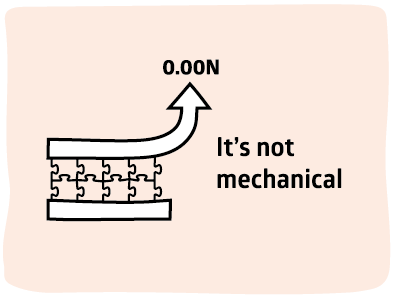It's not mechanical

There is a very popular adhesion myth saying that if you roughen two surfaces you get greater adhesion because the rough parts can form a mechanical lock, with the icon of a jigsaw puzzle showing this as an extreme. A moment 's thought shows that this is nonsense. How can the material somehow move apart to allow the interlocking pieces to come together yet provide a solid resistance when pulled apart?
You don't have to believe me. Prof Kevin Kendall in his marvellous book Molecular Adhesion and Its Applications: The Sticky Universe, Springer, 2001 states clearly that the mechanical explanation is totally wrong.
I have always made an exception for adhesives that can wrap around fibres in, say, paper or board. A reader kindly pointed out another exception, where some amazingly complex "re-entrant" etching could increase adhesion by a factor of 2 or 3. But that's a lot of work to achieve something that could probably done with a few % of some primer that created entanglement across the interface. But the main point is that standard roughening a surface to achieve adhesion via mechanical interlocking is nonsense.
While we 're here, the other myth around rough surfaces is that they have extra surface energy to give extra adhesion. As we will see in the Not Surface Energy page, even if you could double the surface area by roughening (and that's very hard to do) you merely double an irrelevantly small number.
If you don't believe me about roughening a surface, go to the Surface Profile Explorer in Practical Coatings to see what I mean. The "Lr" value is the relative extra length along the surface (going up and down the peaks and valleys) and for most surfaces you will find that it is very close to 1, i.e. no significant extra length or surface area. If you click the Scale option you will see why - a rough surface when drawn to scale isn't rough at all. That 's because the Y-axis is in μm and the X-axis is in mm, so a μm sized roughness looks very large, but not when the Y-axis is made to the same scale as the X-axis.
I am most grateful to Prof Ing Michele Ciavarella of Politecnico di Bari for providing his recent paper 1 which at the same time shows some rare cases of soft rubbers where adhesion can increase by a factor of 2 (though the effect is hard to reproduce in general) and where there was an explanation from Persson saying that it was due to increased surface area. Prof Ciavarella shows elegantly that this is not true and the the increase in adhesion is due to some complex contact mechanics which are beyond my understanding. The key point is that even in the rare case of soft rubber contact adhesion, the "extra surface area" explanation is false.
